- News
- Reviews
- Bikes
- Components
- Bar tape & grips
- Bottom brackets
- Brake & gear cables
- Brake & STI levers
- Brake pads & spares
- Brakes
- Cassettes & freewheels
- Chains
- Chainsets & chainrings
- Derailleurs - front
- Derailleurs - rear
- Forks
- Gear levers & shifters
- Groupsets
- Handlebars & extensions
- Headsets
- Hubs
- Inner tubes
- Pedals
- Quick releases & skewers
- Saddles
- Seatposts
- Stems
- Wheels
- Tyres
- Tubeless valves
- Accessories
- Accessories - misc
- Computer mounts
- Bags
- Bar ends
- Bike bags & cases
- Bottle cages
- Bottles
- Cameras
- Car racks
- Child seats
- Computers
- Glasses
- GPS units
- Helmets
- Lights - front
- Lights - rear
- Lights - sets
- Locks
- Mirrors
- Mudguards
- Racks
- Pumps & CO2 inflators
- Puncture kits
- Reflectives
- Smart watches
- Stands and racks
- Trailers
- Clothing
- Health, fitness and nutrition
- Tools and workshop
- Miscellaneous
- Buyers Guides
- Features
- Forum
- Recommends
- Podcast
£4,200.00
VERDICT:
High-quality privateer 'cross racer that's fast and fun
Fun to ride
Very light
Excellent spec throughout
Tubeless ready
Mudguard compatible
Thru-axles are daft
Gear range a bit limiting if you're not racing
Not the best value
Weight:
7,900g
Contact:
At road.cc every product is thoroughly tested for as long as it takes to get a proper insight into how well it works. Our reviewers are experienced cyclists that we trust to be objective. While we strive to ensure that opinions expressed are backed up by facts, reviews are by their nature an informed opinion, not a definitive verdict. We don't intentionally try to break anything (except locks) but we do try to look for weak points in any design. The overall score is not just an average of the other scores: it reflects both a product's function and value – with value determined by how a product compares with items of similar spec, quality, and price.
What the road.cc scores meanGood scores are more common than bad, because fortunately good products are more common than bad.
- Exceptional
- Excellent
- Very Good
- Good
- Quite good
- Average
- Not so good
- Poor
- Bad
- Appalling
Merida's Mission CX Force Edition is a top-quality cyclo-cross bike that's ready to race straight out of the box. It'll turn its hand to fast gravel riding and winter riding too, if you're looking for something more than just a dedicated race bike.
Let's dive right into the ride. The Mission CX is designed as a cyclo-cross race bike and as such it's not going to mollycoddle you over rough ground: this is a bike for attacking stuff on. It's at its best when you're sprinting up a steep, loose gravel climb or you're finding a fast line through a swoopy bit of singletrack. It's a direct, responsive bike that goes where you point it.
> Find your nearest dealer here
You can't expect a 33mm tyre to offer you much in the way of suspension, and the frame and fork are reasonably stiff, but there's give in the carbon bar, especially in the drops, and the seatpost offers a bit of relief too. On tarmac and more graded gravel surfaces it feels fast and pretty composed; once things start to get lumpier then you'll be feeling it.
On rougher, bumpier surfaces – say a dried out grassy bridleway – the lack of compliance can easily rob you of speed if you're not on your game. But attack the surface – hands on the tops, plenty of power through the pedals, pavé style – and the Merida skips on nicely.
Basically: whatever you're doing, the bike feels better if you're going after it. And given that it's designed to be ranted round a park for an hour with you at your absolute limit, that's entirely how it should be.
The carbon frame – which Merida says contains a 'Nano Matrix' for extra impact resistance – is very stiff through the bottom bracket, and paired with a full carbon fork that feels equally purposeful. It's worth mentioning the sparkly blue paint job here, which is lovely.
Built up in this guise, the bike weighs just 7.9kg without pedals. That's pretty impressive: the same as the mid-range, rim-brake Merida Scultura I race crits on. That lack of mass means it feels very lively and it responds well to being flicked from line to line.
Steering response is very good: the bike isn't twitchy, but neither does it have the relaxed feel of more gravel/distance-orientated bikes. With a head tube angle of 72 degrees and a seat tube angle of 74 degrees, that's not really surprising.
That racy feel sometimes means that the bike feels a bit front heavy on steeper, more technical stuff; it's not particularly at home on trails that you'd normally hit on your full-suspension mountain bike, but you wouldn't really expect it to be. You'll get down them, but you won't enjoy it all that much.
> Your guide to cyclo-cross racing
So who does it suit best? Well, if you're looking for a dedicated cyclo-cross bike for the race season then it's certainly that. Out of the box it's ready to go; the only thing I'd change (and did) would be to take out the inner tubes and set the bike up tubeless. Oh, and if you're actually good at CX racing and you might change wheels because you've got a spare set in the pit lane, then you'll need to ditch the daft thru-axles, with their impossibly fiddly recessed handles that are impossible to use when muddy, and fit some standard DT Swiss ones or something.
Cyclo-cross racing is a fairly small market; if you're just after something that you can ride fast on mixed surfaces then the Merida is that too. It'd be a fast bike around something like the Dirty Reiver, for example, where the vast majority of the ride is on graded gravel; you might lose some time on the few technical sections but the light, fast Merida would easily make up for that on the better-surfaced bits.
It would also be a good choice if your gravel riding is broken up by long sections of tarmac, which is the picture across a lot of the UK. This is a bike that weighs the same as the road bike I race crits on; aside from a bit of extra drag from the tyres it's not going to hold you back much. Just bear in mind that the direct feel of the bike, and the fact that it responds best when you're going hard, can be a bit of a drawback on longer rides where you're having to preserve your effort a bit.
The stock tyres – Maxxis All Terrane 700x33 – are decent race all-rounders, but if you wanted to use the Merida as more of a general purpose gravel bike then there's room in the frame for something like a Schwalbe G-One Allround in a 40mm width, which would be both quicker on the tarmac and a bit more cushioned off it. The Maxxis tyres aren't bad at all though: there's lots of grip on byways and they're quick enough on the road sections. There isn't masses of mud around at the moment (for a change) but on the few slippery bits I've found the tread bites pretty effectively.
Stick some big-chamber slicks on instead and the Misson CX would easily keep up on a winter club run: you'd barely be giving anything away to a road race bike, and you can spec bigger tyres to deal more effectively with winter detritus.
The bike has hidden mudguard mounts, which Liam pooh-poohed when he reviewed the Ultegra build of this bike, but I can't really see the problem: they don't add any weight and they're barely noticeable, so there's no reason not to have them and they make the bike more versatile. You could race the 'cross season until February and then slap some slicks and 'guards on and hit the tarmac for some base miles.
The tyres are rolling on a set of Vision SC40 Disc wheels, which put in a faultless performance during testing. They're easy to set up tubeless, they put up with some pretty heavy hits on the more technical stuff and they're well behaved on the road. The 19mm rim width is good for anything from a 28mm road tyre up to the biggest rubber the frame will hold.
Force groupset
Merida has specced this bike with SRAM's Force eTap AXS groupset, which brings road wireless shifting down a tier from the top-dollar Red groupset. It's on the Merida in a 1x configuration, and for 'cross racing that would absolutely be my choice: the front derailleur is often the first thing to fill up with mud, and the single 38-tooth chainring and 10-33t 12-speed cassette give a range of gears that's perfect for an hour of pain, with reasonable gaps between them.
If you're aiming to point the Merida at longer loops, though, then you might find the stock gearing a bit limiting; on a four-hour ride that was about half and half tarmac and various other surfaces there were occasions where I wished I had another gear at either end.
> Read our review of SRAM's Force eTap AXS Wide groupset here
You can play with the chainring and cassette to tweak the range, but those aren't especially cheap components to swap out if you're not happy with what's supplied. The Mission CX has a mount for an AXS front mech if you wanted to widen the bike's range even further by putting on a double chainset. That's super-easy when there aren't any wires to poke through the frame. But again: spendy.
Functionally, the SRAM Force eTap AXS groupset is excellent. You have a gear lever each side, and in this 1x configuration you just click the lever corresponding to the way you want the mech to go: left to go up the cassette, and right to go down. It takes a bit of getting used to if you're accustomed to Shimano/SRAM/Campagnolo gears because you don't normally use your left hand to push the rear mech. But once you've done the learning bit it's easy.
The shift quality is flawless: it's crisp and precise across the whole cassette, with no variation in the feel of the shift. With a mechanical groupset you tend to know when you've run out of gears on a climb as the small differences in the lever feel give it away; with an electronic groupset it's often rather unwelcome news as all the changes feel the same.
The battery in the rear mech has a claimed life of 60 hours and takes less than an hour to charge; the charger is small and USB-powered, so if you were on a big adventure you could take the charger and charge it from a battery or wall socket. In normal use it's not an issue, although it's good practice to charge the battery before a long ride.
Value
It's a high-spec bike with a high-ticket price, and in terms of value you'd have to say it's not the best out there.
> Buyer’s Guide: 14 of the best cyclo-cross bikes
Although you can easily spend more – the Specialized Crux Expert is £4,249 with the mechanical version of this groupset – Cube's Cross Race C:62 boasts a similar spec and weight for £500 less. We haven't tried that bike but we have reviewed the Vitus Energie CRX, which is excellent, and that bike is available with carbon race wheels, Zipp finishing kit and the same groupset for under three grand. It's hard to look past that in terms of value if you're a privateer racer.
Conclusion
I really enjoyed riding the Mission CX: it's a proper cyclo-cross race bike and it's light and engaging. It's versatile enough to be ridden well beyond the taped confines of a cyclo-cross course of a Sunday morning.
> Watch it in action here, in Merida’s video
Verdict
High-quality privateer 'cross racer that's fast and fun
road.cc test report
Make and model: Merida Mission CX Force Edition 2020
Size tested: Large
About the bike
List the components used to build up the bike.
Merida lists:
FRAME MISSION CX CF3
FRAME SIZE XS, S, M, L, XL
COLOR GLOSSY SPARKLING BLUE/BLACK (LIME)
FORK MISSION CX CF3
BRAKE FRONT Sram ED Force eTap AXS
BRAKE REAR Sram ED Force eTap AXS
ROTOR FRONT Sram DB ROTOR CLX R CNTRLOCK
ROTOR REAR Sram DB ROTOR CLX R CNTRLOCK
BRAKE LEVER Sram ED Force eTap AXS
HEADSET VP-B303AC Neck
HANDLEBAR MERIDA TEAM SL
HANDLEBAR STEM MERIDA EXPERT CC
GRIP MERIDA ROAD EXPERT
DERAILLEUR (R) Sram Force eTap AXS
SHIFTER FRONT Sram Force eTAP AXS HRD
SHIFTER REAR Sram Force eTAP AXS HRD
SEAT POST MERIDA TEAM SL
SEAT CLAMP MERIDA Expert
SADDLE MERIDA EXPERT CC
CHAIN Sram Force chain
CHAINWHEEL Sram Force eTap AXS
CRANK SIZE 170 mm-XS/S, 172.5 mm-M, 175 mm-L/XL
FREEWHEEL CS XG 1270 D1
BOTTOM BRAKET Sram Pressfit Dub
WHEELSET Vision SC 40DB
TIRE FRONT Maxxis All Terrane
TIRE REAR Maxxis All Terrane
AXLE REAR Fulchee FH1700BK002 12-142
WEIGHT 8.02 kg
Tell us what the bike is for and who it's aimed at. What do the manufacturers say about it? How does that compare to your own feelings about the bike?
This bike is marketed as a cyclo-cross race bike, and certainly it's very much at home in a race scenario, although it's versatile enough for other uses too.
Where does this model sit in the range? Tell us briefly about the cheaper options and the more expensive options
This is the top model in the range. There are Ultegra (CX7000) and SRAM Apex 1 (CX5000) builds too.
Frame and fork
Overall rating for frame and fork
9/10
Tell us about the build quality and finish of the frame and fork?
Build is very tidy, paint finish is lovely.
Tell us about the materials used in the frame and fork?
The frame is Merida's CF3 carbon mix; it doesn't specify what the fibres are but that's the middle of the three available mixes.
Tell us about the geometry of the frame and fork?
It's a race bike, so fairly aggressive in its geometry.
Stack: 572mm
Reach: 401mm
HT angle: 72°
ST angle: 74°
Wheelbase: 1029mm
How was the bike in terms of height and reach? How did it compare to other bikes of the same stated size?
More aggressive than some of its direct competitors.
Riding the bike
Was the bike comfortable to ride? Tell us how you felt about the ride quality.
The ride I'd describe as purposeful. It's not designed to be hugely comfortable but it's fast on rough terrain.
Did the bike feel stiff in the right places? Did any part of the bike feel too stiff or too flexible?
Very solid-feeling throughout.
How did the bike transfer power? Did it feel efficient?
Yes, very responsive to rider input.
Was there any toe-clip overlap with the front wheel? If so was it a problem?
No issues.
How would you describe the steering? Was it lively neutral or unresponsive? Lively.
Tell us some more about the handling. How did the bike feel overall? Did it do particular things well or badly?
It's quite active in its steering feel, but stops short of being twitchy.
Which components had the most effect (good or bad) on the bike's comfort? would you recommend any changes?
The bar is good for a bit of vibration damping, especially in the drops.
Which components had the most effect (good or bad) on the bike's stiffness? would you recommend any changes?
No changes.
Which components had the most effect (good or bad) on the bike's efficiency? would you recommend any changes?
No changes.
Rate the bike for efficiency of power transfer:
9/10
Rate the bike for acceleration:
8/10
Rate the bike for sprinting:
7/10
Rate the bike for high speed stability:
8/10
Rate the bike for cruising speed stability:
8/10
Rate the bike for low speed stability:
7/10
Rate the bike for flat cornering:
8/10
Rate the bike for cornering on descents:
8/10
Rate the bike for climbing:
8/10
The drivetrain
Rate the drivetrain for performance:
10/10
Rate the drivetrain for durability:
8/10
Rate the drivetrain for weight:
9/10
Rate the drivetrain for value:
6/10
Wheels and tyres
Rate the wheels for performance:
9/10
Rate the wheels for durability:
8/10
Rate the wheels for weight:
8/10
Rate the wheels for comfort:
7/10
Rate the wheels for value:
6/10
Rate the tyres for performance:
8/10
Rate the tyres for durability:
7/10
Rate the tyres for weight:
7/10
Rate the tyres for comfort:
7/10
Rate the tyres for value:
7/10
Controls
Rate the controls for performance:
8/10
Rate the controls for durability:
8/10
Rate the controls for weight:
8/10
Rate the controls for comfort:
7/10
Rate the controls for value:
6/10
Your summary
Did you enjoy riding the bike? Yes
Would you consider buying the bike? I think my head would be turned by cheaper alternatives.
Would you recommend the bike to a friend? Maybe
How does the price compare to that of similar bikes in the market, including ones recently tested on road.cc?
The Vitus Energie CRX is one of our favourite privateer race bikes and a Force AXS build is £2,999. Cube's Cross Race C:62 is £3,499 in a similar build. A Specialized Crux Expert is more than the Merida with a mechanical groupset. It's nearer the top of the price bracket than the bottom though.
Rate the bike overall for performance:
8/10
Rate the bike overall for value:
5/10
Use this box to explain your overall score
Overall it's a good bike for the money. The performance is definitely on point, but privateer racers might have their heads turned by other bikes with similar builds and cheaper price tags.
About the tester
Age: 47
I usually ride: whatever I'm testing... My best bike is: Kinesis Tripster ATR, Merida Scultura, Dward Design fixed
I've been riding for: Over 20 years I ride: Every day I would class myself as: Experienced
I regularly do the following types of riding: road racing, time trialling, cyclo cross, commuting, touring, club rides, sportives, general fitness riding, fixed/singlespeed, mtb, Mountain Bike Bog Snorkelling, track
Dave is a founding father of road.cc, having previously worked on Cycling Plus and What Mountain Bike magazines back in the day. He also writes about e-bikes for our sister publication ebiketips. He's won three mountain bike bog snorkelling World Championships, and races at the back of the third cats.
Latest Comments
- bobbinogs 2 sec ago
Yepp, fantastic coverage. It seems strange that WBD have forced me to spend less and get better coverage! Thing is, I would have been happy with a...
- David9694 47 min 39 sec ago
+1 on saddle height and also check your lateral alignment - everything should be straight and aligned. My bike fit years ago moved my feet to the...
- froze 51 min 51 sec ago
Everything Lezyne sells are really good, especially their pumps, and the Torque Drive. ...
- wtjs 1 hour 35 min ago
It's not only the UK which suffers from vile louts-VdP is a great athlete who deserves respect!
- Hirsute 2 hours 11 min ago
https://www.youtube.com/watch?v=wOzP87HVCWw
- Rendel Harris 3 hours 37 min ago
Apart from the fact that you're completely wrong - Decathlon is a French company and has 1045 stores in Europe compared to 50 in the UK - whilst...
- hawkinspeter 5 hours 43 min ago
Finally tried out the Smart Lever that I did get for Xmas as I had a suspicious looking bubble/bump on my rear GoodYear tyre (don't think I'll buy...
- chrisonabike 8 hours 46 min ago
Further motoring exemptions have been highlighted by a certain celebrity lawyer: needing the loo, being a well-known footballer...








































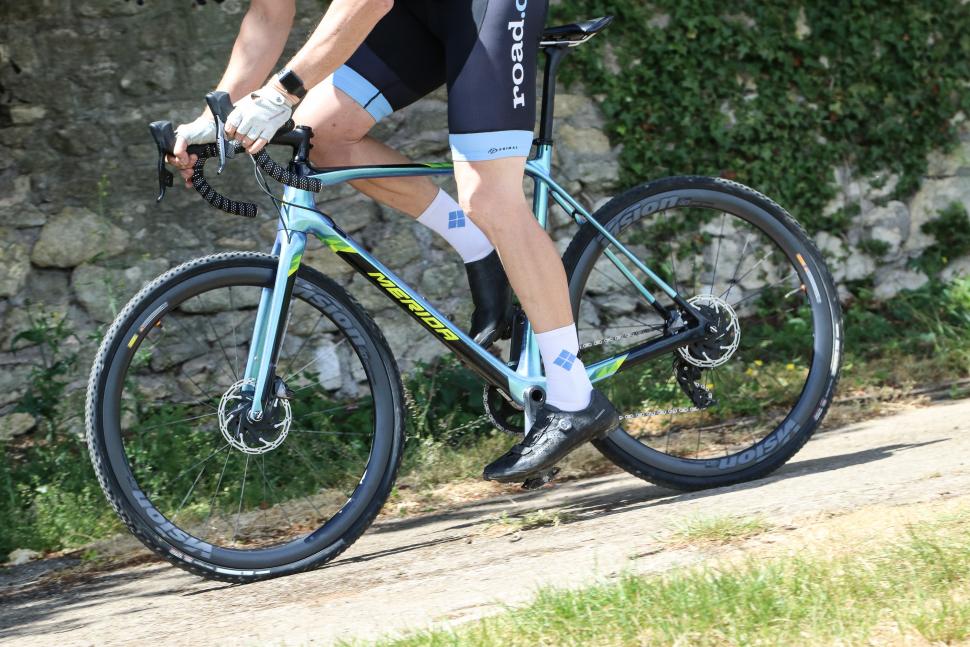

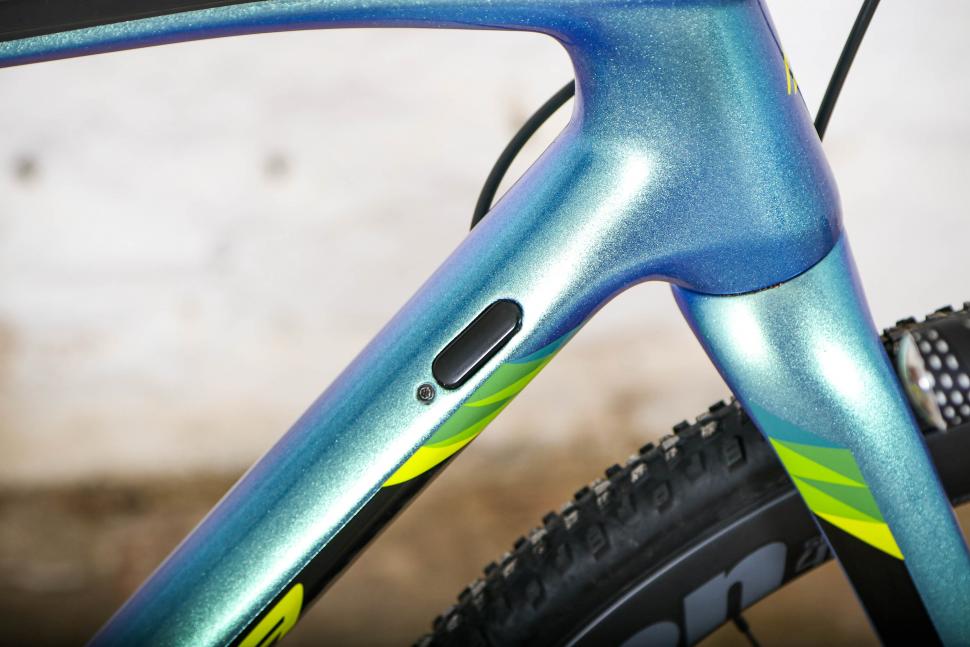
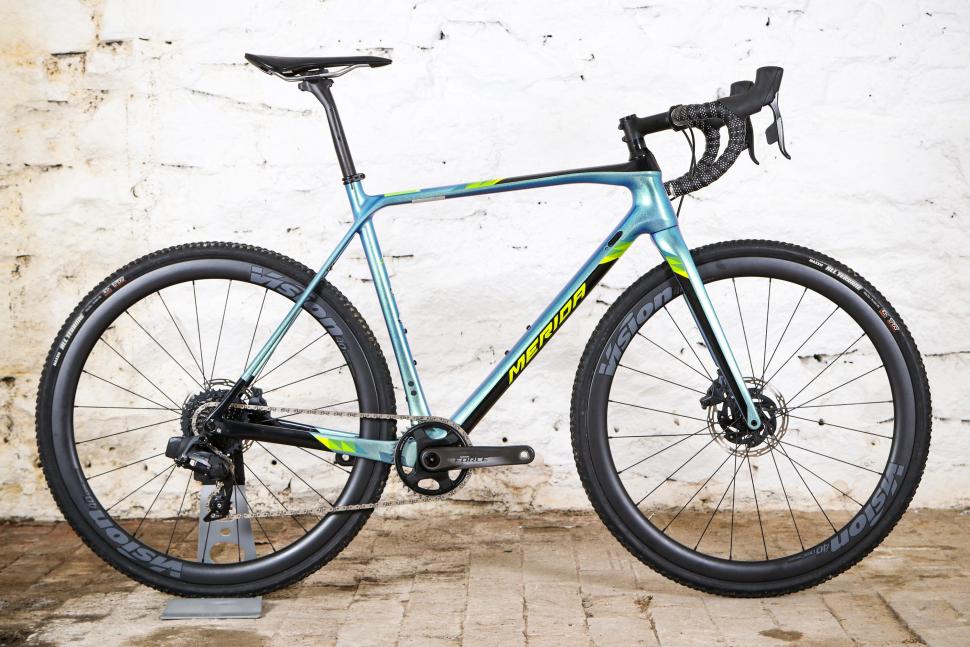
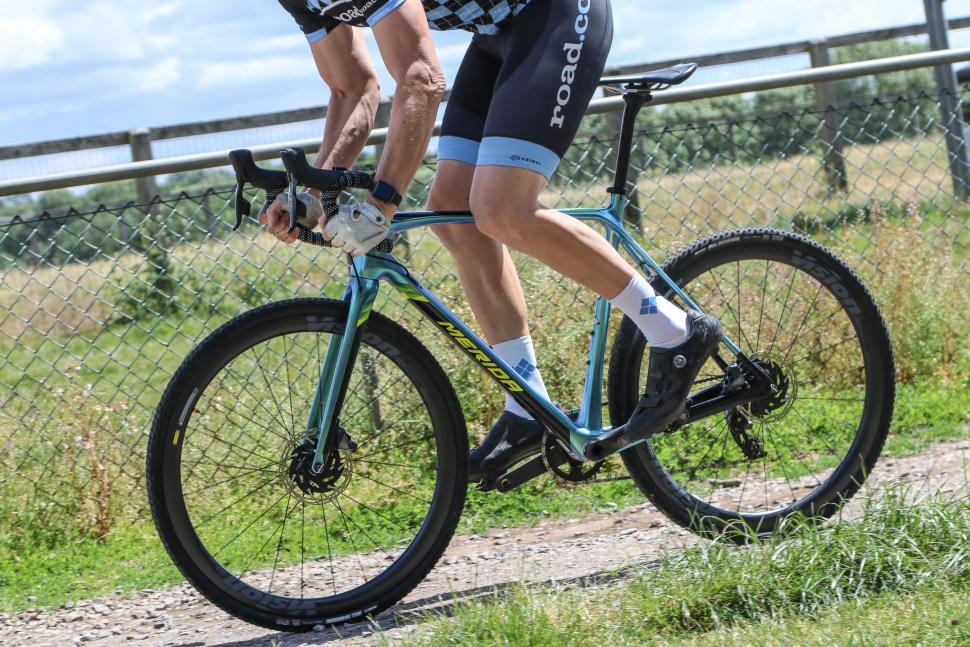
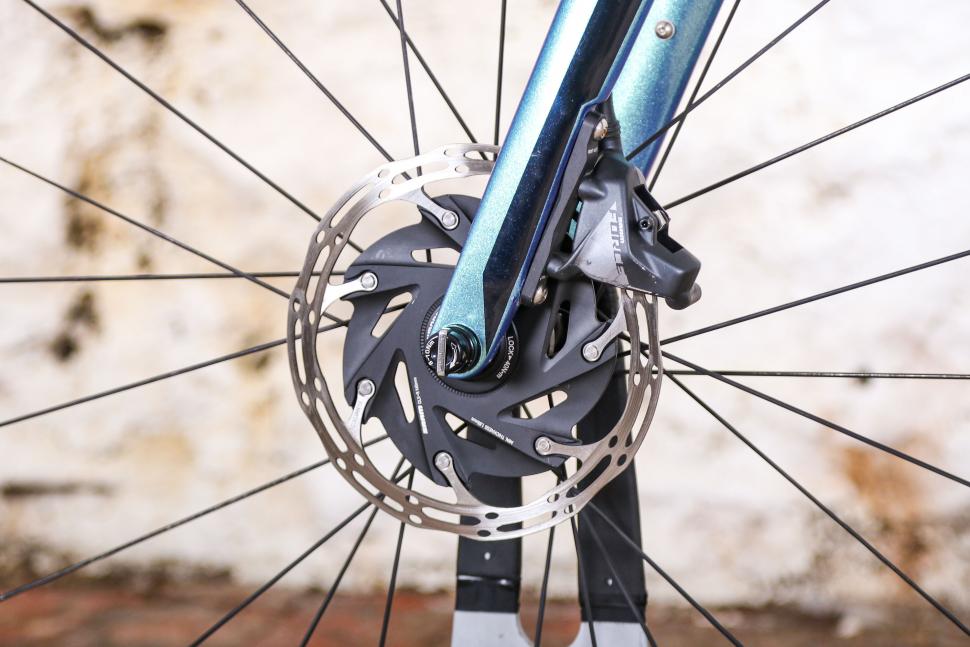
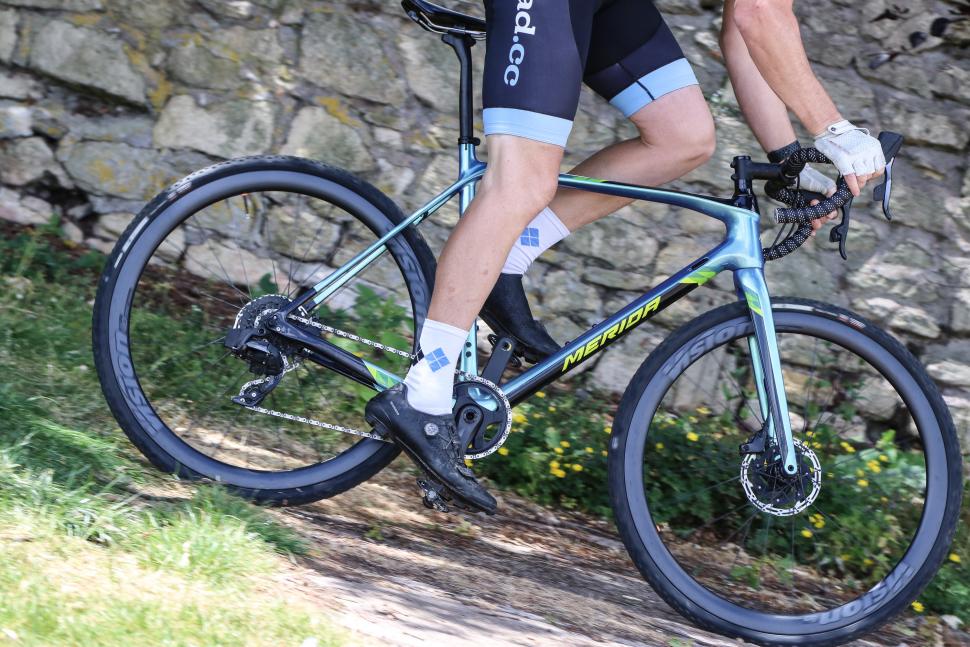

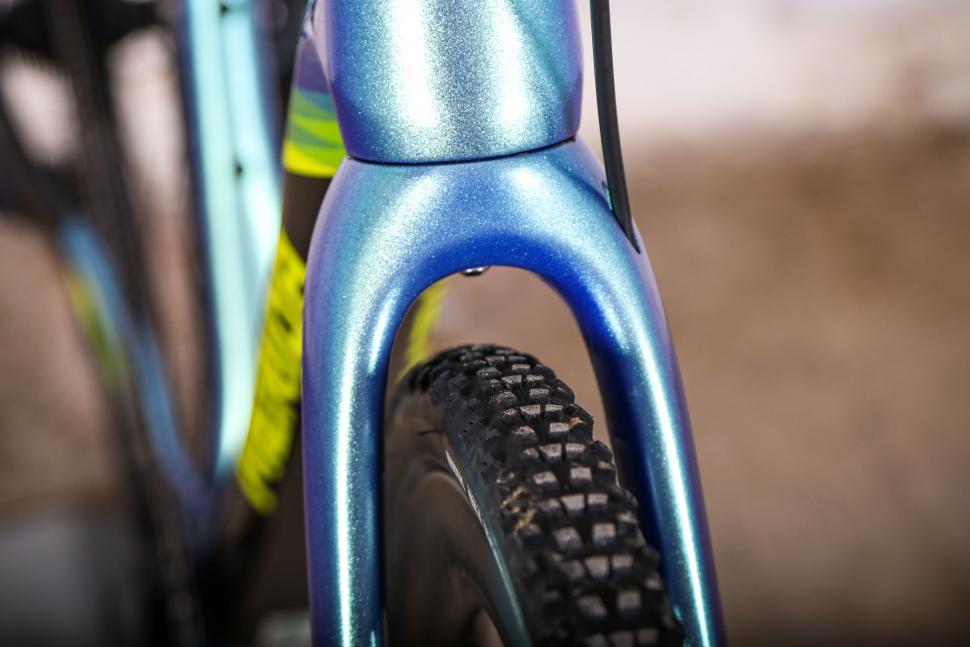
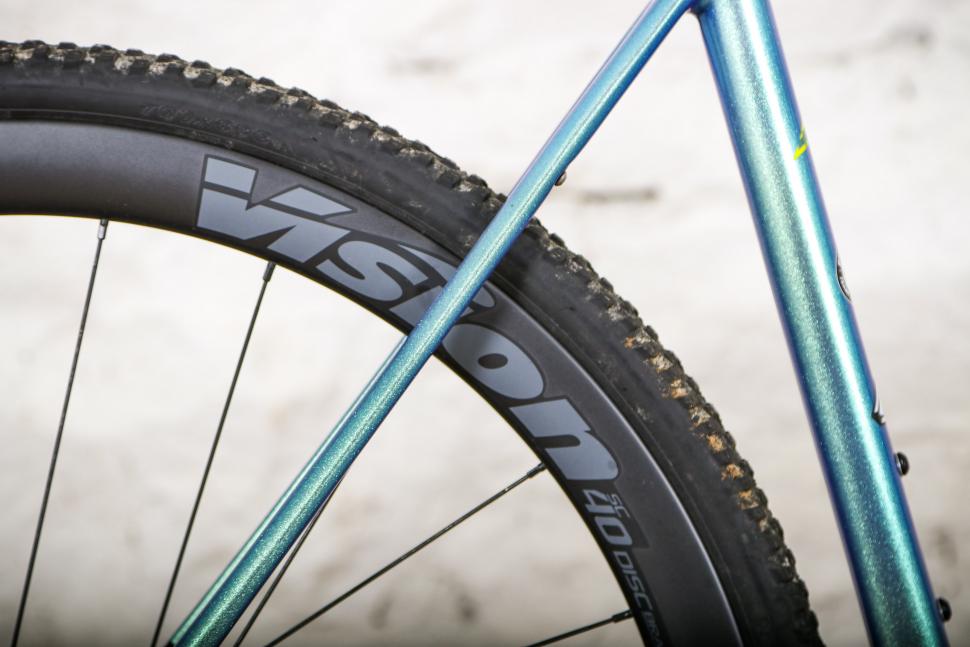
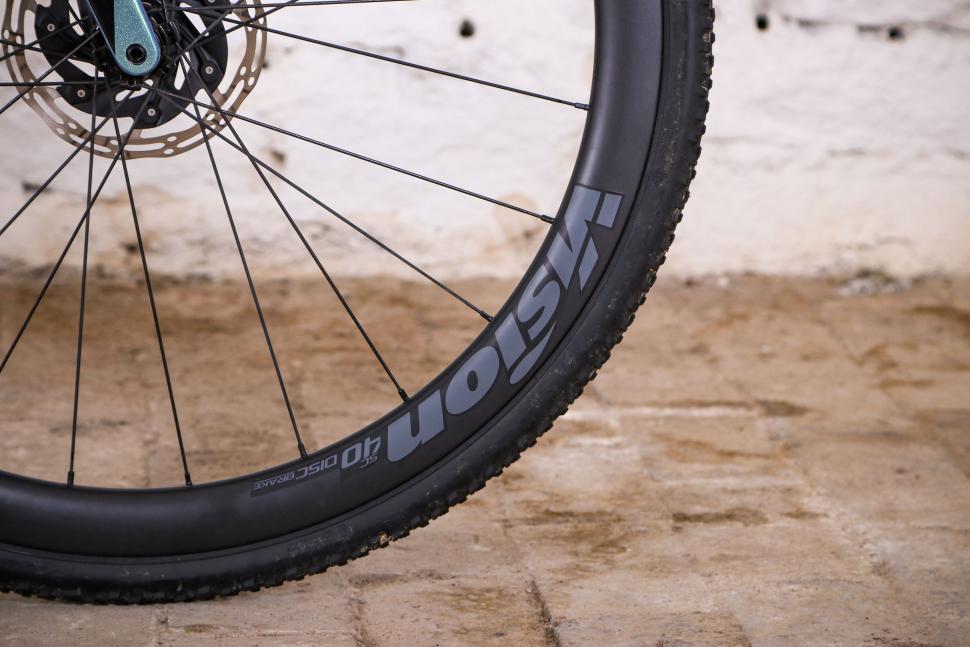
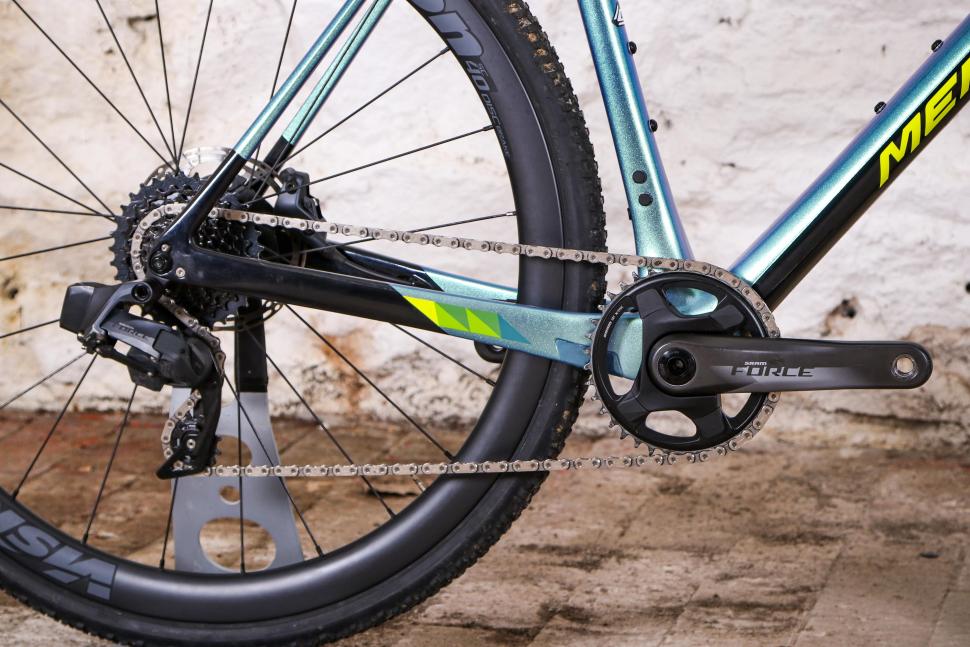
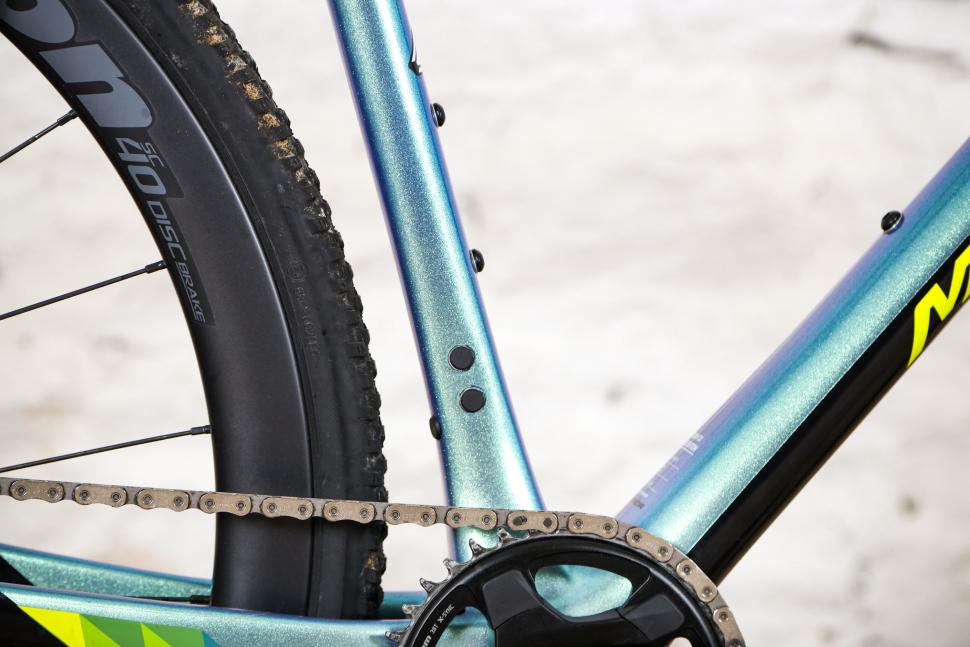
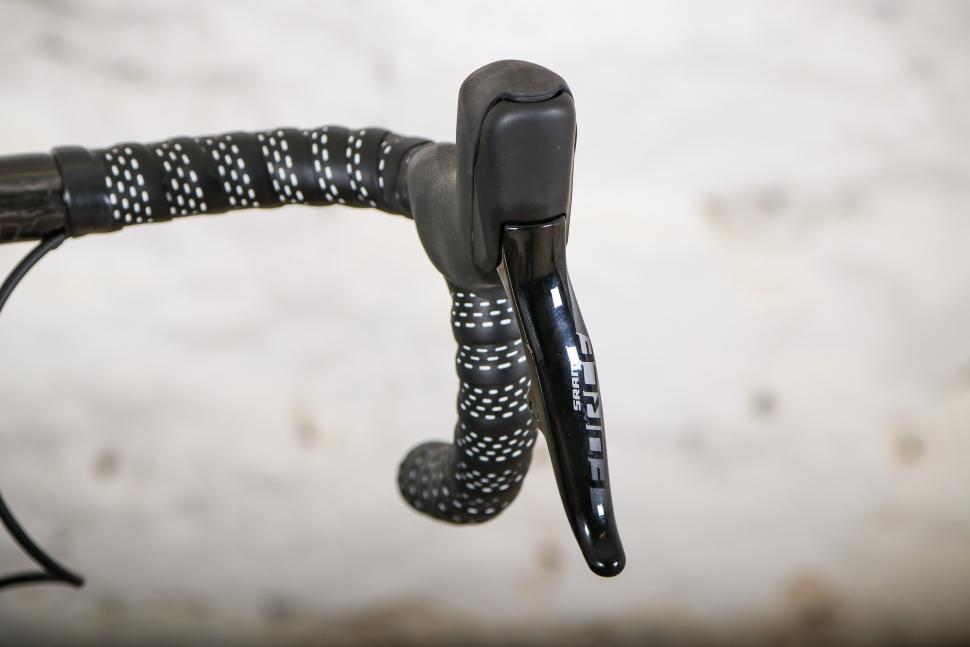




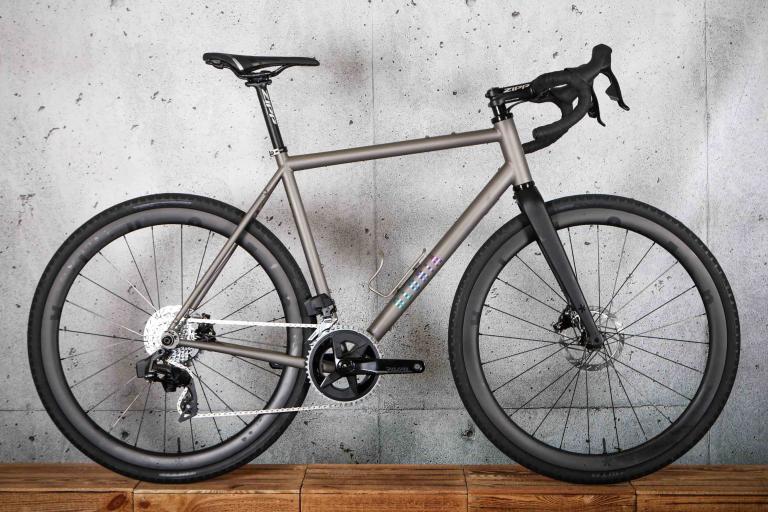
Add new comment
2 comments
A pretty funky looking bike but I'm not sure about the lime green and sparkly blue together. A bit harsh to judge it was a gravel bike- it's not, it's a CX bike, it's for riding hard with appropriate gearing over a short course - it's specced well.
It's too expensive though, Merida is a big box brand, it should be £500 less.
That would be harsh, if that was what I'd done, which it isn't